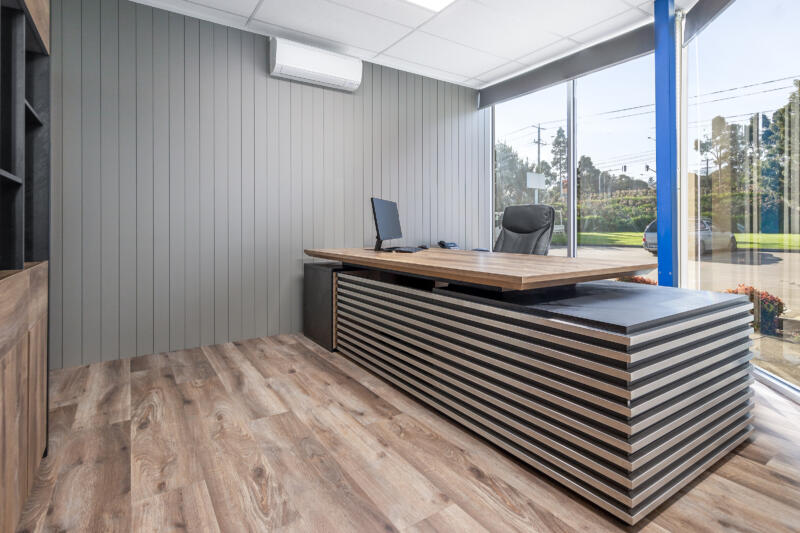Enhancing Aesthetic Appeal and Ensuring Durability
Step into the world of indoor wall cladding, where aesthetic appeal and durability converge to transform your space into a stunning masterpiece. Whether you’re renovating your home or designing a commercial space, this guide will walk you through the remarkable possibilities and advantages of interior wall cladding—an architectural marvel that’s gaining popularity in modern design.
What is Indoor Wall Cladding?
Indoor wall cladding refers to the decorative wall panels and protective wall coverings applied to the interior walls of a building. Serving a dual purpose, wall cladding enhances the aesthetic appeal of your space while providing a durable surface. Available in materials like natural stone wall cladding, wooden wall panels, ceramic tiles, and engineered composites, each option brings unique characteristics to the table.
Durability is key when selecting materials, as wall cladding shields walls from wear and tear, moisture, and other environmental factors. This not only extends the lifespan of your walls but also prevents costly repairs. Many types of cladding are designed for easy maintenance, making them ideal for high-traffic areas or spaces that require frequent cleaning.
The Importance of Aesthetic Appeal in Interior Design
In interior design, aesthetic appeal plays a crucial role. The appearance of a room can significantly impact the mood, productivity, and overall well-being of its occupants. Indoor wall cladding elevates the visual appeal of any space, instantly transforming bland walls into striking features. Whether you opt for the warmth of wooden wall cladding, the sleekness of modern stone cladding, or the vibrant patterns of decorative wall tiles, the right cladding sets the tone for your interior design.
Attention to detail in the installation and integration of cladding with other design elements, such as lighting and furniture, further enhances the aesthetic appeal. By carefully selecting the appropriate wall cladding materials and styles, you can create a visually captivating and harmonious environment.
Understanding the Durability of Indoor Wall Cladding
When it comes to interior wall cladding, durability is just as important as appearance. A well-chosen wall covering not only enhances the look of your space but also stands the test of time. Natural stone cladding, for example, is known for its resistance to scratches, stains, and other types of damage, making it ideal for high-traffic areas.
Proper installation is critical to ensuring the longevity of your cladding. High-quality adhesives, sealants, and meticulous attention to detail during installation can prevent issues like cracking or detachment, maintaining the integrity and durability of your walls.
Pros and Cons of Indoor Wall Cladding Materials
Here’s a look at the pros and cons of popular indoor wall cladding materials:
Natural Stone:
– Pros: Exceptional durability, timeless appeal, and low maintenance.
– Cons: Expensive, heavy, and requires specialized installation.
Wood:
– Pros: Warm, natural aesthetic, easy to install, eco-friendly.
– Cons: Susceptible to moisture and requires regular maintenance.
Ceramic Tiles:
– Pros: Durable, versatile in design, easy to clean, and cost-effective.
– Cons: Prone to chipping, requires precise installation.
Engineered Composites:
– Pros: Highly durable, lightweight, and low maintenance.
– Cons: Can be more expensive and lacks the natural appeal of other materials.
By weighing these pros and cons, you can choose the indoor wall cladding that best fits your design vision, budget, and maintenance needs.
Installation Process of Indoor Wall Cladding
The installation process of indoor wall cladding is crucial for ensuring both aesthetic appeal and durability. Proper preparation of the underlying wall, including cleaning and priming, is essential. A well-planned layout, careful alignment, and secure installation using high-quality adhesives contribute to a seamless and long-lasting finish.
Whether you’re tackling the installation yourself or hiring a professional, understanding these key steps can make all the difference in the success of your project.
Maintenance and Care for Indoor Wall Cladding
Maintaining the beauty and durability of your indoor wall cladding is essential. Regular cleaning with the appropriate products and addressing any signs of wear promptly will keep your cladding looking its best. For materials like wood and natural stone, periodic maintenance such as refinishing or re-sealing may be required to preserve their appearance and protect against environmental factors.
By following these maintenance tips, you can ensure that your wall cladding remains a stunning feature in your home or commercial space for years to come.
Conclusion: The Impact of Indoor Wall Cladding on Aesthetics and Durability
Indoor wall cladding is more than just a decorative element; it’s a powerful tool for transforming spaces. With its combination of aesthetic appeal and durability, cladding can turn any room into a visual masterpiece while providing long-lasting protection. Whether you choose natural stone, wood, ceramic tiles, or engineered composites, the right wall cladding can significantly enhance the interior design of your space.
Ready to explore the world of indoor wall cladding? Embrace the endless possibilities and let your creativity soar as you create spaces that captivate and inspire.

